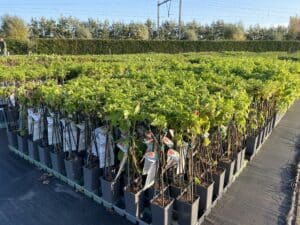BLOG: Grower Fruithof
You may have heard of “De Fruithof”, as our webshop menu has a separate tile for this grower. This nursery specialises in fruit trees and plants for garden centres. The owner jokingly calls himself a fruit-freak. At the nursery I was given an afternoon of lessons in fruit trees, in fact I really only had to ask one question: Who is Wim Kersten?
‘I’m 51 years old, married, with two sons and a daughter. When I started working for a living, I ended up at a company that grew fruit trees for fruit tree cultivation. A few of the saplings were sold to garden centres, but the quality of these was inferior to the high-quality examples sent to fruit growers. I thought that was a wasted opportunity, as the consumer is also entitled to a decent fruit tree. In 1999, I started ‘De Fruithof’ and I was able to make my vision a reality on the consumer market.’

‘Besides the poor quality of the fruit trees, I was also unhappy with the small labels with hardly any information at the time. I’m an amateur photographer, so I took photos of all the blossoms and fruits of my varieties, and worked on designing the perfect label. This label was much larger than normal, and full of information in four languages.
When the product and label were ready for the market, I drove to a good local garden centre. I showed them my beautiful trees, and the buyer was very enthusiastic until it turned out that the price was a bit on the high side. He didn’t have the courage to buy my trees and raise the retail price. I said, “I’ll leave 50 trees here with you. See what happens with the higher price, and then I’ll come back and collect what hasn’t been sold in 3 weeks’ time. All the trees were sold and my instincts were confirmed; you can get a long way with good quality and presentation.
By 2001, I had the production and presentation where I wanted them, and the concept was working really well. Business was booming! Our range back then was the same as now, so large fruit (apple, pear, peach, etc.) and small fruit (blackberry, raspberry, etc.). The Dutch garden centres were wildly enthusiastic. I realised that good presentation was even more important than I’d first thought, and the next step was to literally take the small fruit to a higher level. If you don’t put it on the floor in a garden centre, but on a table with the attractive label at eye level, sales really take off.’
Sap flow wizardry
‘People are constantly changing. Years ago, it was an advantage to have large fruit trees with long branches in the store. These days, people are afraid of trees, and will only dare to buy one if you assure them that they’re dwarf trees. Fortunately, you can make fruit trees grow in all kinds of ways, you just need to focus on the sap flows. If the sap flows easily and reaches the crown quickly, then the tree uses its energy to promote vegetative growth. That means the branches grow quickly, and hardly any fruit is produced. The moment the sap flow is restricted, the growth becomes generative; the tree produces fruit instead of growing larger.
So we started working on the ideal fruit tree that remains compact. The most important factor is the rootstock. A rootstock that is too long and too thick will send much too much sap to the crown. We started using 20-cm rootstocks for our patio trees, of which 15-cm is planted under the ground. The fruit species is grafted to the rootstock by shield budding [see box]. This creates a small S-bend at the base of the tree, the sap flow is restricted, and the result is a compact tree with lots of fruit.’
Future
‘We’ve designed sales modules for garden centres. This hardware is a practical way of presenting the products and giving the consumer clear information, something the consumer clearly needs to make a purchase. The themes are “City Gardening” and “Wonder Tree”. In Northwest Europe, a number of garden centres are already using our modules. We also want to supply the rest of Europe with our range in the future. We’ve even been able to buy some extra land nearby, so we’ll be able to scale up our production.
Published on: 16 February 2022